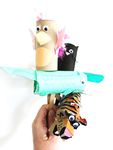Tuatara and the Sun Years 5-8 - School-Gen
←
→
Page content transcription
If your browser does not render page correctly, please read the page content below
Tuatara
and the Sun
Years 5-8
Overview
Investigate why the Sun is so important for tuatara and
learn about the differences between ectotherms
(‘cold-blooded’ animals) and endotherms
(‘warm-blooded’ animals).
Curriculum links: NZ Curriculum
LEARNING AREAS ACHIEVEMENT OBJECTIVES LEVELS YEARS
Science:
Recognise that there are life processes common to all
Living World: 3-4 5-8
living things and that these occur in different ways.
Life processes
Explain how living things are suited to their particular
Living World:
habitat and how they respond to changes: both natural 3-4 5-8
Ecology
and human induced.
Other links:
Nature of Science: Communicating in science; Investigating in science
English: Listening, Reading and ViewingTeacher information
Learning sequence
Introducing Explore and Make and share Reflect and Make a difference
knowledge investigate extend
Learning intentions
Students are learning to:
• identify why the Sun is important for tuatara
• recognise differences between cold-blooded animals (ectotherms)
and warm-blooded animals (endotherms)
Example success criteria
Students can:
• describe why the Sun is important for tuatara
• sort statements which describe endotherms and ectotherms
Resources needed
Tuatara and the Sun presentation
Vocabulary:
Tuatara, endotherm/ cold-blooded animal, warm-blooded/ endothermic animal, hibernate, reptile,
survive, sun, heat.
Background information
Tuatara are endemic, endangered New Zealand reptiles. Reptiles have a backbone (spine), scales,
and lay eggs. Although tuatara belong to the reptile group, they are not lizards. The closest relatives
of tuatara were a group of extinct reptiles called Rhynchocephalia. They have some unique ancient
features such as two rows of teeth in the top of the skull, a spiny egg-tooth and a third eye.
The name tuatara means ‘peaks on the back’ or spiny back in te reo Māori. At this time, tuatara are only
found in the wild on offshore islands, due to habitat loss and introduced predators.
2Learning experience suggestions
Note: These are suggestions only and teachers are encouraged to adjust the activity to suit the needs and
interests of their students.
1. Introducing knowledge
Allow approximately 20 minutes
Introducing the tuatara and cold-blooded animals (ectotherms)
• View the Tuatara and the Sun presentation
• Also view the Genesis School-gen video: Tuatara encounter: (4 minutes
long). The video is also part of the slideshow above.
• After viewing, discuss what a tuatara is, why the Sun is important for tuatara and what an
ectotherm/ cold-blooded animal is.
Slideshow: Tuatara and the Sun presentation (Google Slides): preview slides
2. Explore and investigate
Timing will vary
Thinking like a scientist:
observing cold-blooded animals/ectotherms
If possible, students could visit tuatara or other cold-blooded animals (such as reptiles or
amphibians) to observe their behaviour in and out of the sun. Notice the weather and the Sun’s
position during your visit and see if this has any effect on the behaviour of the ectotherms. You
can find tuatara on many offshore islands, such as Tiritiri Matangi island (north Auckland) and
Matiu Somes Island (Wellington). They are also kept at some zoos and wildlife parks, including
Auckland Zoo, Hamilton Zoo, Zealandia (Wellington) and Kiwi Birdlife Park (Queenstown).
Alternatively, a staff member or student may have a reptile as a pet which could be borrowed
for observation. 33. Make and share
Allow approximately 20 minutes
Students can create puppets or recycled art of
tuatara and other ectotherms and endotherms.
These puppets were made using paper towel
rolls, cardboard, felts, feathers, googly eyes and
coloured paper.
4. Reflect and extend
Allow approximately 10 minutes
Students can try the sorting animals and cold and warm blooded animals
on page 6 of this activity, or from the Tuatara and the Sun slideshow
(Google Slides) (slides 14 and 15). Remember to share the slideshow as an assignment in the
classwork tab of your Google Classroom, selecting ‘make a copy for each student’ in the drop
down menu (as pictured below) giving each student their own copy so that the drag and drop
will work for individuals.
5. Make a difference
Allow approximately 15-30 minutes
• Discuss the threats for tuatara, e.g. climate change, introduced
predators such as rats and stoats and habitat loss. What can we do
about these threats? Commit to an action that will make a difference for one of these threats.
For example, start trapping rats, planting trees or walk, bike or scooter for short journeys.
• If you’re visiting offshore islands where tuatara live, be sure you don’t take pests with you
by checking your bags for pests thoroughly before you leave the mainland. Stay off islands
where there is a no-landing rule.
• Support a restoration project where tuatara live or a wildlife park or zoo which helps with
captive breeding.
• Do you think it would be possible to one day have tuatara back in mainland New Zealand?
How could we help this to happen? Try some persuasive writing to unpack your argument.
45
Drag and drop: Cold and warm blooded animals
Cut out the descriptions in the text boxes on the right and stick them into the right columns.
Cold-blooded animals Warm-blooded animals Get their energy from
(Ectotherms) (Ectotherms) their enviroment e.g. the Sun
Get their energy from food
Move into the sunlight to keep
themselves warm
Can sweat or shiver
to change temperature
Have to eat regularly
Cannot seat or shiver
Are not able to survive in very
hot or cold temperatures
Can keep a constant temperature
Further information and supporting resources
• DOC information: Tuatara
• Science Learning Hub
• Zoo tales video: Truly unique tuataraYou can also read

























































